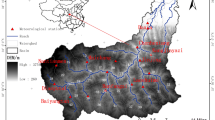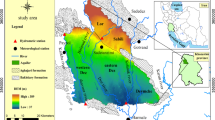Abstract
Global climate change causes a high variability in precipitation and surface temperature increase in the world. Global climate models (GCMs) are effectively used to predict climate change at a global scale. In contrast, regional climate models (RCMs) can more efficiently predict climate change scenarios for a small territory such as South Korea. We estimated the groundwater level change in four drainage basins (the Han River, Nakdong River, Geum River, and Yeongsan-Sumjin River basins) in South Korea over the period 2000–2012, and then predicted the groundwater level change from 2000 to 2100 using a water budget model, considering RCMs with RCP 4.5 and RCP 8.5 scenarios. A distinct trend in the groundwater levels of each drainage basin was detected via the inversely close relationship with precipitation patterns of the drainage basin, showing a decrease in the groundwater level in relation to the increasing precipitation trend of the RCM scenarios. It is also proposed that the precipitation amount during the dry season more dominantly affects groundwater recharge than during the wet season.
Similar content being viewed by others
Explore related subjects
Discover the latest articles and news from researchers in related subjects, suggested using machine learning.References
Ali, R., McFarlane, D., Varma, S., Dawes, W., Emelyanova, I., Hodgson, G., and Charles, S., 2012, Potential climate change impacts on groundwater resources of south-western Australia. Journal of Hydrology, 475, 456–472.
BGR (Bundessanstalt für Geowissenschaften und Rohstoff), 2008, Groundwater and climate change: Challenges and possibilities. Hetzel, F., Vaessen, V., Himmelsbach, T., Struckmeier, W., Villholth, K.G. (eds).
CCIC, 2014, http://www.climate.go.kr/.
Fan, Y., Li, H., and Miguez-Macho, G., 2013, Global patterns of groundwater table depth. Science, 339, 940–943.
Goes, B.J.M., 1999, Estimate of shallow groundwater recharge in the Hadejia-Nguru wetlands, semi-arid northeastern Nigeria. Hydrogeology Journal, 7, 294–304.
Healy, R.W. and Cook, P.G., 2002, Using groundwater levels to estimate recharge. Hydrogeology Journal, 10, 91–109.
IPCC, 2014, http://www.ipcc.ch/.
Ketchum, J.N. Jr., Donovan, J.J., and Avery, W.H., 2000, Recharge characteristics of a phreatic aquifer as determined by storage accumulation. Hydrogeology Journal, 8, 579–593.
Kim, G.B., 2005, Nationwide monitoring and assessment of groundwater in Korea. Ph.D. thesis, Seoul National University, Seoul, 391 p.
Koo, M.-H. and Lee, D.-H., 2002, A numerical analysis of the water level fluctuation method for quantifying groundwater recharge. Journal of the Geological Society of Korea, 38, 407–420.
Koo, M.-H., Kim, T.-K., Kim, S.-S., Chung, S.-R., Kang, I.-O., Lee, C.-J., and Kim, Y., 2013, Estimating groundwater recharge using the water-table fluctuation method: effect of stream-aquifer interactions. The Journal of Soil and Groundwater Environment, 18, 65–76.
Lee, B., Hamm, S.-Y., Jang, S., Cheong, J.-Y., and Kim, G.-B., 2014, Relationship between groundwater and climate change in South Korea. Geosciences Journal, 18, 209–218.
Lee, J.-Y., Yi, M.-J., Lee, J.-M., Ahn, K.-H., Won, J.-H., Moon, S.-H., and Cho, M., 2006, Parametric and Non-parametric trend analysis of groundwater data obtained from national groundwater monitoring stations. The Journal of Soil and Groundwater Environment, 11, 56–67.
Loáiciga, H.A., 2003, Climate change and ground water. Annals of the Association of American Geographers, 93, 30–41.
Lubchenco, J. and Karl, T.R., 2012, Predicting and managing extreme weather events. Physics Today, 65, 31–37. doi: 10.1063/PT.3.1475.
Moon, H.J., 2007, Policies for the rational utilization and management of groundwater Resources. Korea Environment Institute, RE-16: 259.
Moon, S.-K. and Woo, N.-C., 2001, Estimation of groundwater recharge ratio using cumulative precipitation and water-level change. The Journal of Soil and Groundwater Environment, 6, 33–43.
Moon, S.-K., Woo, N.-C., and Lee, K.-S., 2004, Statistical analysis of hydrographs and water-table fluctuation to estimate groundwater recharge. Journal of Hydrology, 292, 198–209.
MLTM (Ministry of Land, Transport and Maritime Affairs), 2012, Korean National Groundwater Management Master Plan, 10–11.
Oh, J.-H., Kim, T., Kim, M.-K., Lee, S.-H., Min, S.-K., and Kwon, W.-T., 2004, Regional climate simulation for Korea using dynamic downscaling and statistical adjustment. Journal of Meteorological Society of Japan, 82, 1629–1643.
Park, E., 2007, A development of groundwater level fluctuations due to precipitations and infiltrations. The Journal of Soil and Groundwater Environment, 12, 51–56.
Park, Y.-C., Jo, Y.-J., and Lee, J.-Y., 2011, Trends of groundwater data from the Korean National Groundwater Monitoring Stations: indication of any change? Geosciences Journal, 15, 105–114.
Vörösmarty, C.J., Green, P., Salisbury, J., and Lammers, R.B., 2000, Global water resources: Vulnerability from climate change and population growth. Science, 289, 284–288.
Author information
Authors and Affiliations
Corresponding author
Rights and permissions
About this article
Cite this article
Jang, S., Hamm, SY., Yoon, H. et al. Predicting long-term change of groundwater level with regional climate model in South Korea. Geosci J 19, 503–513 (2015). https://doi.org/10.1007/s12303-015-0002-9
Received:
Accepted:
Published:
Issue Date:
DOI: https://doi.org/10.1007/s12303-015-0002-9




